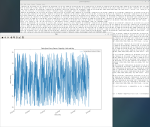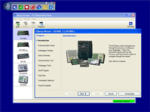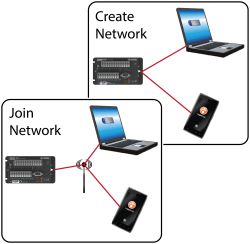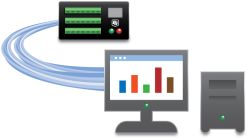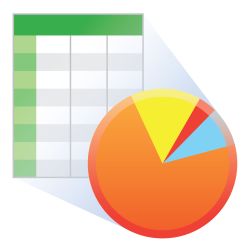
Prestaciones avanzadas en programación y comunicaciones






Resumen
LoggerNet es nuestro principal paquete de software de soporte para datalogger. Permite programar, comunicar y descargar datos del logger al PC.
LoggerNet consiste en una aplicación servidor y varias aplicaciones cliente, integradas en un mismo producto. Permite lógicamente comunicar con un solo datalogger, pero su punto fuerte es el gestionar una red con muchos dataloggers, así como las particularidades de las telecomunicaciones y descargas de datos programables.
El acuerdo de licencia de uso de LoggerNet está disponible en el Manual de LoggerNet
Leer másVentajas y características
- Crea programas de datalogger personalizados mediante Edlog o CRBasic
- Gráficos de datos en tiempo real e históricos
- Creación de pantallas de visualización para visualizar datos, puertos de control y flags
- Descarga datos mediante cualquiera de nuestras opciones en telecomunicaciones
- Procesa ficheros de datos mediante la aplicación Split
- Guarda los datos en formatos (incluso CSV y XML) que pueden ser importados a aplicaciones de terceros
Imágenes

Descripción detallada
The standard LoggerNet software package is recommended for those who have data logger networks that do not require the more advanced features offered in LoggerNet Admin. It includes the LoggerNet server and client applications. The LoggerNet server stores the data in a cache and writes data to a variety of formats, including ASCII, binary, and XML.
The LoggerNet server and client applications enable you to do the following:
- Configure the server to communicate with multiple data loggers via a variety of communications hardware
- Create custom data logger programs using Short Cut, Edlog, or the CRBasic Editor
- Connect to a data logger to check or set the clock, send programs, or perform other administrative functions
- Collect data on demand or schedule
- Monitor and troubleshoot the network
- Display real-time data in a numeric display or graph
- View and graph data files
- Create graphical data displays that update when data is collected and allow you to control flags, ports, and variables
- Create automated tasks
- Process data files using Split
- Save data in formats (including CSV and XML) that can be imported into third-party analysis packages.
The client applications included in the standard LoggerNet software package are the following:
- Setup
- Connect
- Status Monitor
- Task Master
- Short Cut
- CRBasic Editor
- Edlog
- Transformer
- RTMC Development
- RTMC Run-Time
- View Pro
- Split
- CardConvert
- Troubleshooter
- Network Planner
- PakBus Graph
- LogTool
- Device Configuration Utility
- CoraScript
Version History
|
Productos similares
Preguntas frecuentes
Número de FAQs relacionadas con LoggerNet: 139
Expandir todoDesplegar todo
-
There are several approaches you can try:
- The LNDB Interface can pull data from LoggerNet and insert it into a database instance. Supported database platforms are as follows: Microsoft SQL; MySQL; unofficially, MariaDB as it is open source MySQL, PostGRESQL, and Oracle. The database table structure and metadata will match the structure of the station’s program and the station name used in LoggerNet exactly. You cannot customize the structure. Refer to the setup documentation.
- Read or parse data from LoggerNet .dat files. The files are CSV formatted and can be parsed in using most any programming language. Files by default are stored on the LoggerNet computer in the following path: C:\Campbellsci\LoggerNet.
- LDMP Server, a LoggerNet Admin component, offers a listening socket for data to be pulled directly from the LoggerNet cache over the LoggerNet Service listening port 6789. Complete documentation in LoggerNet Admin is stored in the following path: C:\Program Files (x86)\Campbellsci\LoggerNet\ldmp_server2.pdf.
- Read in data using the CSI web server’s built in Web API. The webAPI accepts queries in the same format as the data logger’s built-in webAPI. Refer to the data logger webAPI documentation.
-
OSIsoft sells a PI interface for LoggerNet. The OSIsoft part number is PI-IN-CS-LN-NTI. Please direct all inquiries for sales and support of the interface to OSIsoft.
-
Changes
- Enhanced performance of the CRBasic Editor when checking for matching parentheses.
Bug Fixes
Note: The following fixes only apply to customers who are upgrading to LoggerNet 3.1.1 from LoggerNet 2.x:
- Data file paths for table-based dataloggers appeared to be distorted in the Setup Screen.
- Numeric Monitor displayed inlocs from some table-based dataloggers incorrectly.
-
If communication is interrupted or intermittent, LoggerNet may stop updating the Table Monitor, Numeric Display, and Graphs. When this occurs, a button on the display that is normally titled Stop (to stop the update) changes to Start, and the button must be pressed to resume the update. Also, check the update interval on the display, as it may be set to a higher value than expected.
-
- LoggerNet 4.0 introduces a new look and feel to the LoggerNet Toolbar. Applications are divided into categories to make navigating the Toolbar easier. You can also organize a Favorites category for the applications that you use most often.
- A new file viewing application, View Pro, is introduced in which LoggerNet 4.0. View Pro allows you to graph data in a variety of formats including Line Graph, X- Y Plot, Histogram, Rainflow Histogram, and FFT(2D or 3D).
- Another new application, the Network Planner, is included. The Network Planner is a graphical application that assists the user in designing PakBus datalogger networks.
LoggerNet 4.0 includes many additional changes. See the preface to the LoggerNet manual for more details on what is new in LoggerNet 4.0 and each individual application.
-
In the LoggerNet Setup screen, on the Data Files tab, there are these Collect Mode options:
- Data Logged Since Last Collection
- Most Recently Logged Records
- Collect At Most
-
No, but the Help in the Edlog and CRBasic editors is complete with all of this information. The CRBasic Editor Help also includes extensive examples.
-
Follow these steps:
- In the Setup screen, record the pertinent data from the Schedule and Data Files tabs.
- Delete the listed data logger.
- Add the new data logger.
- Adjust the settings on the Schedule and Data Files tabs to match what was being done previously.
- If the settings are complicated, review the Help menu from the Setup screen to learn more about the option in LoggerNet 4.2 to Copy Device Settings in the Tools menu.
-
Yes. If the data logger has a phone modem connected, there are Edlog and CRBasic commands that can be used to initiate calls. For example, in CRBasic a call can be made with SerialOpen(), SendVariables(), and SerialClose() instructions.
-
The LoggerNet server imposes no specific limits on the lengths of the generic modem scripts.
Compatibilidad
Nota: lo siguiente muestra información de compatibilidad notable. No es una lista de todos los productos compatibles.
Dataloggers
| Producto | Compatible | Nota |
|---|---|---|
| 21X (retired) | The 21X requires three PROMs; two PROM 21X Microloggers are not compatible. | |
| CR10X (retired) | LoggerNet is compatible with the mixed array, PakBus®, and TD operating systems. | |
| CR23X (retired) | LoggerNet is compatible with the mixed array, PakBus®, and TD operating systems. | |
| CR510 (retired) | LoggerNet is compatible with the mixed array, PakBus®, and TD operating systems. |
Dispositivos Comunicaciones
| Producto | Compatible | Nota |
|---|---|---|
| KonectPBRouter |
Software
| Producto | Compatible | Nota |
|---|---|---|
| KonectGDS |
Información de compatibilidad adicional
Data Logger Considerations
LoggerNet supports Campbell Scientific data loggers.
Communications
LoggerNet runs on a PC, using serial ports, telephony drivers, and Ethernet hardware to communicate with data loggers via phone modems, RF devices, and other peripherals.
Software
The development tool of RTMC Pro 1.x and 2.x is not compatible with the RTMC run-time and the standard RTMC development tool in LoggerNet 4. An upgrade for RTMC Pro must be purchased separately.
Computer
LoggerNet is a collection of 32-bit programs designed to run on Intel-based computers running Microsoft Windows operating systems. LoggerNet runs on Windows 10 and Windows 11. LoggerNet runs on both 32-bit and 64-bit versions of these operating systems.
Other Products
LoggerNet supports most commercially available sensors, SDM devices, multiplexers, relays, vibrating-wire interfaces, ET107, CompactFlash cards, microSD cards, and PC cards.
Especificaciones
| Operating System | Windows 11 or 10 (Both 32- and 64-bit operating systems are supported.) |
| Requirement | .NET 4.6.2 |
| Purchased Separately | Yes |
| Software Level | Intermediate to advanced |
| Communications Supported |
Direct connect, Ethernet, short-haul, phone modems (land-line, cellular, voice synthesized), RF transceivers (UHF, VHF, and spread spectrum), multidrop modems Combinations of communication devices supported. |
| Scheduled Data Collection Supported | Yes |
| Data Display Supported | Numeric, graphical, Boolean data objects |
Military Certificate of Networthiness (CoN) |
|
| Certifications |
|
Documentos
Folletos producto
Casos de aplicación
Videos & Tutoriales
Descargas
LoggerNet Patch v.4.10 (437 MB) 07-07-2025
This patch will upgrade LoggerNet, LoggerNet Remote or LoggerNet Admin version 4.0 and newer to 4.10. A version of LoggerNet 4.x must be installed on the computer.
Note: This patch includes RTMC Run-time and the RTMC Standard Development v5.0.1. If you are using RTMC Pro 4.3.3 or older or CSI Web Server 1.6 or older and plan to continue creating RTMC projects, we recommend that you opt out on updating RTMC during the install or upgrade to RTMC Pro v5.0.1.
LoggerNet Admin and Remote:
A change was made in the way the LoggerNet 4.6 Server performs "Custom Data Collection". A corresponding change was made in the Connect Screen 4.6 client "Custom Data Collection" functionality.
If you require "Custom Data Collection" functionality with the Connect Screen client, assure that the LoggerNet Servers and Connect Screen clients are 4.6 or higher.
This application requires the Microsoft .Net 4.6.2 Framework. If it is not already installed on your computer, it can be obtained from the Microsoft Download Center.
Supported Operating Systems: (32 and 64 bit) Windows 11 or 10.
What's new in LoggerNet 4 Tutorial (exe format) v.- (12.9 MB) 14-09-2009
LoggerNet 4.0 was released in August of 2009. This tutorial demonstrates some of the new features and enhancements. Two new applications, View Pro and the Network Planner, are introduced.
LoggerNet Trial v.4.10 (422 MB) 07-07-2025
This is a fully functional 30 day trial of the standard version of LoggerNet. This is a trial only and can not be activated as a full version with a license key. (Network setup and data is preserved from the trial when installing the full version.)
Current LoggerNet users: It is recommended that you install the trial on a computer other than the one running your existing LoggerNet. If that is not practical, we strongly recommend you back up the LoggerNet working directory to prevent backward compatibility issues if you revert to a previous version. To revert you must re-install LoggerNet using the original disk and software key.
Note: This application requires the Microsoft .Net 4.6.2 Framework. If it is not already installed on your computer, it can be obtained from the Microsoft Download Center.
Supported Operating Systems: (32 and 64 bit) Windows 11 or 10.
Casos de aplicación
In 2019, Campbell Scientific embarked on a significant project with the Malawi Department of Climate......leer más
The Delaware Department of Transportation (DelDOT) notified Intelligent Infrastructure Systems (IIS) and Pennoni of the......leer más
Intelligent Infrastructure Systems, a Pennoni company, was contracted to design and install an efficient structural-health......leer más
In April of 2015, Sandia National Laboratories (SNL) contracted with Montrose Air Quality Services (MAQS)......leer más
The cultivation of rice—the staple food for India, as well as for approximately half the......leer más
Due to its geographical position close to the Black Sea, the local climate in Moldova......leer más
System integrator Hortus Srl installed a Campbell Scientific CS725 SWE sensor (Snow Water Equivalent) in......leer más
Artículos y notas de prensa
Artículos boletín
- Case Study: Webcams in New Hampshire Forest 15-10-2015
- Case Study: South Africa Solar Prospecting 14-04-2015
- Case Study: Solar-Energy Assessment in Chile 20-10-2014
- Case Study: South Dakota Irrigation Update 30-07-2014
- Case Study: Florida Endangered Species 30-07-2014
- Case Study: Flood Warning in Arkansas 15-10-2013
- Case Study: Preventing Road Damage from Freezing Conditions in South Korea 09-05-2013
- New LoggerNet Release Coming Soon! 09-05-2013
- Case Study: North Carolina “Green” Hotel 18-10-2012
- Case Study: Water-Supply SCADA System 15-03-2012
- Introducing LoggerNet 4 16-10-2009

